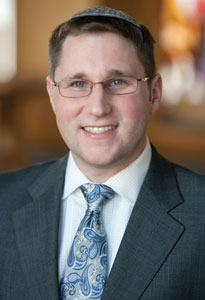 When native Kansas Citian Corey Helfand was in first grade, he played “the rabbi” in a siddur celebration at Hyman Brand Hebrew Academy. So his longtime HBHA friends weren’t surprised when he changed his focus at Washington University from pre-med to the rabbinate.
When native Kansas Citian Corey Helfand was in first grade, he played “the rabbi” in a siddur celebration at Hyman Brand Hebrew Academy. So his longtime HBHA friends weren’t surprised when he changed his focus at Washington University from pre-med to the rabbinate.
“I’m a pre-med dropout,” he said in a recent interview. “I did two years of chemistry and biology and decided the relationship was over.” Though his major remained Judaic studies and political science even while he was pre-med, he realized that his goal of helping people could only be achieved by going to rabbinical school.
“I took a year off after college to study in Israel,” he explained, “to determine if the rabbinate was really the right path for me.” A 2005 cum laude graduate of Wash U, Helfand graduated in May with 26 others from the Jewish Theological Seminary in New York City and also earned a Master of Arts degree in Talmud and rabbinics and pastoral care.
At only 28, newly-ordained Rabbi Helfand is one of eight rabbinic graduates to receive full-time positions as senior pulpit rabbis; six others will be assistant rabbis. Peninsula Sinai Congregation in Foster City, Calif., a 215-member Conservative congregation, located north of Palo Alto, will be Helfand’s new home.
The son of Richard and Vicki Helfand, Rabbi Helfand is no stranger to the organized Jewish world; he describes his parents as “engaged and empowered.” They are active members of Congregation Ohev Sholom and both volunteered at HBHA when Corey and his younger brothers, Ethan and David, were students. Richard is International Secretary of United Synagogue of Conservative Judaism and Vicki is active with Ohev’s Sisterhood.
Rabbi Helfand also credits HBHA with sparking his interest in Judaism. “I had some great Hebrew teachers — Sari Havis and Edna Meltzer,” he said, “and I loved the curriculum.” He also cites his high school experiences in BBYO and USY — including USY Pilgrimage to Israel summer trip for teens and March of the Living — as developing his love for Israel and the Jewish people.
“Teens want something meaningful,” he said, “something out-of-the-box.” While a student rabbi at Conservative Synagogue Adath Israel in Riverdale, just north of JTS, Helfand started a Jewish Teens for Justice. Under the mentorship of Rabbi Barry Dov Katz, “We discussed hot-button issues that culminated in a teen service trip to New Orleans,” Helfand said, adding that the group also initiated get-togethers with a youth group from the East Bronx. He wants to do that at Peninsula Sinai as well.
That’s not all he has planned. Building on his experience as a Gladstein Fellowship rabbinic intern in North Carolina, Rabbi Helfand would like to expand his weekly Torah commentary to include one-on-one prayer, meet members and others on their turf, and initiate a “listening tour.”
“Corey’s leadership skills come from a rare combination of empathy, instinct and knowledge,” said Ned Gladstein, a JTS board member who created the Gladstein Fellowship in Entrepreneurial Rabbinics. “His listening skills are extraordinary, and enable him to understand the key points, as well as needs of people on various sides of an issue, to craft unique and effective solutions. He has gained the respect and affection of his congregants and peers alike, and, I’m sure, will continue to touch many people with his kindness.”
But Rabbi Helfand doesn’t want the synagogue to become his only focus: “I want the community to be my agenda. I want Judaism to be accessible.” He doesn’t want to wait for Jews to come to him and hopes to offer classes at participants’ homes or offices, or even local colleges. “I want to meet new people, not just synagogue members. Everyone wants to be heard,” he said. “And it’s my job to listen.”
The interview process is where this goal became most apparent for him. He was asked: “How are you going to fix all our problems?” He countered with “What do you love about this place?” And he discovered that many search committee members were passionate about their synagogue. “So many people have great ideas, but they don’t know what to do about it,” Rabbi Helfand said. “What you do (at a synagogue) should reflect your goals and mission.”
And in order to do that, he would like to conduct “listening campaigns” at Peninsula Sinai. “I’d like to train people to lead them, take notes and bring them back to leadership,” he added. He described one instance where someone asked about suffering in Judaism. “Was he asking about something theological or something personal?” he asked himself. “If it’s personal, I don’t want to miss that. If he’s hurting, I want to hear the story.”
Rabbi Helfand’s list of awards and prizes demonstrate that listening and follow-up are his great strengths. From valedictorian of HBHA to Dean’s List and the Steven Schwarzchild Prize for Outstanding Undergraduates for academic achievement at Wash U, Rabbi Helfand added several more awards at JTS. He won three prizes for outstanding work in Talmud as well as one for Hebrew literature.
“Since I began rabbinic school, I have reaffirmed my love of studying Torah, practicing the tradition, being a presence in the lives of others, and being part of a learning/spiritual community,” he said, “where you can learn as much, if not more, from those you teach.”
Married to Jennifer Ackerman of Dallas, the couple have an 8-month-old daughter, Eden Leora.
The couple met during Corey’s post-college year in Israel at the Conservative Yeshiva. She was studying for a master’s degree in public health at Hadassah Hospital in Jerusalem. “Jenny’s twin brother learned two desks over from me at the same yeshiva. She would frequently visit as well as participate in programs at the yeshiva,” he recalled. “One afternoon, Jenny and I were sitting at the same table. The conversation turned to cooking and I mentioned that I bake challah. We had our first date a couple of months later; we baked challah for Shabbat. The rest is history!”
In addition to internships in Riverdale and North Carolina, Rabbi Helfand also worked at Congregation Hakrayot in Kiryat Bialik near Haifa for a year. He was the first American rabbi to intern at a Masorti (traditional Conservative) synagogue in Israel, serving with the congregation’s spiritual leader, Rabbi Mauricio Balter. “Having met Jenny in Israel, I thought it fitting to spend our first year of marriage back in Jerusalem,” he said. And, “this was the first time I had taken classes in Hebrew, which I found to be challenging yet fulfilling.”
As to the challenges of being the young rabbi of an established congregation, Rabbi Helfand said, “Now more than ever, rabbis of today are more aware of the issues facing American Jewry, specifically in the Conservative Movement. I find that younger rabbis approach Judaism through social justice, community organizing, ethics and values. At the same time, the continuing struggle for any rabbi is to make Judaism exciting and enticing, without pushing anyone away.”
By the way, Rabbi Helfand almost became Cantor Helfand. His love of hazzanut (cantorial music) comes from his relationship with “Cantor Cyrus Spungen, of blessed memory, who helped me fall in love with Jewish liturgy and Torah,” when he became Bar Mitzvah at Beth Shalom.
“I actually applied to both rabbinical school and cantorial school. While I knew a tremendous number of the melodies (nusach) I knew almost no musical theory,” he smiled.
“Who knows? Maybe someday I’ll be a singing rabbi!”

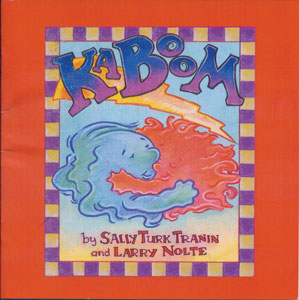 NOT SO SCARY — When Sally Tranin’s grandchildren (Alex and Emily Tranin and Nathan and Lewis Greenstein) were young, they were afraid of storms. So Tranin wrote a picture book, illustrated by Larry Nolte, called “Kaboom,” to help them better understand storms. Tranin was kind enough to donate some books to the Salvation Army when she wrote it. Following this year’s stormy season, Tranin was asked if she could donate more books, which she happily did.
NOT SO SCARY — When Sally Tranin’s grandchildren (Alex and Emily Tranin and Nathan and Lewis Greenstein) were young, they were afraid of storms. So Tranin wrote a picture book, illustrated by Larry Nolte, called “Kaboom,” to help them better understand storms. Tranin was kind enough to donate some books to the Salvation Army when she wrote it. Following this year’s stormy season, Tranin was asked if she could donate more books, which she happily did.  MORE LOCKS OF LOVE — Young girls in the Jewish community are learning about doing personal mitzvahs at an early age. Recently 3 ½-year-old Elia Remi Ellis had her first haircut ever at Michael Shae Salon in Leawood and chose to donate two 9-inch ponytails to Locks of Love. Mother Andrea Ellis said Elia’s hair was so long she was having horrible problems with tangles. As they discussed the need for a haircut, they impressed on the little girl, who attended camp this summer at the Jewish Community Center and is a preschool student at the Rose Family Early Childhood Education Center at Congregation Beth Shalom, how much she could help others by donating her hair to Locks of Love and how special it would be for her to do a mitzvah. Mom said it was an awesome moment and Elia is very excited and proud of her donation.
MORE LOCKS OF LOVE — Young girls in the Jewish community are learning about doing personal mitzvahs at an early age. Recently 3 ½-year-old Elia Remi Ellis had her first haircut ever at Michael Shae Salon in Leawood and chose to donate two 9-inch ponytails to Locks of Love. Mother Andrea Ellis said Elia’s hair was so long she was having horrible problems with tangles. As they discussed the need for a haircut, they impressed on the little girl, who attended camp this summer at the Jewish Community Center and is a preschool student at the Rose Family Early Childhood Education Center at Congregation Beth Shalom, how much she could help others by donating her hair to Locks of Love and how special it would be for her to do a mitzvah. Mom said it was an awesome moment and Elia is very excited and proud of her donation.


 When Alan Gaylin decided to open a second restaurant at Corinth Square, he wanted it to be different than other restaurants in the area. He came up with the concept he now calls Urban Table, which opened Monday, Aug. 1, at 8332 Mission Road in Prairie Village. The Jewish man, along with partners Glenn and Jean Roberts, owns Urban Table’s parent company, Bread & Butter Concepts, which also owns BRGR Kitchen + Bar in Corinth.
When Alan Gaylin decided to open a second restaurant at Corinth Square, he wanted it to be different than other restaurants in the area. He came up with the concept he now calls Urban Table, which opened Monday, Aug. 1, at 8332 Mission Road in Prairie Village. The Jewish man, along with partners Glenn and Jean Roberts, owns Urban Table’s parent company, Bread & Butter Concepts, which also owns BRGR Kitchen + Bar in Corinth. The Vaad Hakashruth of Kansas City has hired Rabbi Mendel Segal as its new executive director. The local community service organization whose mission is the maintenance of kosher supervision here in town had been without a full-time executive director for more than a year. Rabbi Segal has been on the job since July 5.
The Vaad Hakashruth of Kansas City has hired Rabbi Mendel Segal as its new executive director. The local community service organization whose mission is the maintenance of kosher supervision here in town had been without a full-time executive director for more than a year. Rabbi Segal has been on the job since July 5. When native Kansas Citian Corey Helfand was in first grade, he played “the rabbi” in a siddur celebration at Hyman Brand Hebrew Academy. So his longtime HBHA friends weren’t surprised when he changed his focus at Washington University from pre-med to the rabbinate.
When native Kansas Citian Corey Helfand was in first grade, he played “the rabbi” in a siddur celebration at Hyman Brand Hebrew Academy. So his longtime HBHA friends weren’t surprised when he changed his focus at Washington University from pre-med to the rabbinate. Orit Kamara teaches Hebrew at Johnson County Community College. It’s no secret the junior college offers the course and it’s easy to find by searching JCCC’s online catalog. But Kamara said not many people really know it’s available.
Orit Kamara teaches Hebrew at Johnson County Community College. It’s no secret the junior college offers the course and it’s easy to find by searching JCCC’s online catalog. But Kamara said not many people really know it’s available. When you think of summer camp, you think of swimming, sports and arts and crafts. For 160 campers from 26 countries, eCamp is “the ultimate summer experience in Israel,” creating, inventing and designing projects in technology workshops with the 120 computers and exploring Israeli technology.
When you think of summer camp, you think of swimming, sports and arts and crafts. For 160 campers from 26 countries, eCamp is “the ultimate summer experience in Israel,” creating, inventing and designing projects in technology workshops with the 120 computers and exploring Israeli technology. The language of the camp is English. Campers attend three technology workshops (called labs) of their choosing (all done on computers except ones like digital photography, video filming and entrepreneurship), between 9 a.m. and 4 p.m. with up to eight people. At the conclusion of each session, each camper has a final project. They also have one and a half hours a day “unplugged” when they participate in sports and recreation. They also have rest time, access to a canteen in which to purchase snacks, unit activities and camp-wide programs. The camp also brings entrepreneurs from Israel’s high-tech industries to share their experiences with the campers.
The language of the camp is English. Campers attend three technology workshops (called labs) of their choosing (all done on computers except ones like digital photography, video filming and entrepreneurship), between 9 a.m. and 4 p.m. with up to eight people. At the conclusion of each session, each camper has a final project. They also have one and a half hours a day “unplugged” when they participate in sports and recreation. They also have rest time, access to a canteen in which to purchase snacks, unit activities and camp-wide programs. The camp also brings entrepreneurs from Israel’s high-tech industries to share their experiences with the campers. FIVE-TIME GOLD MEDALIST — Earlier this month Alan Poisner participated in the World Masters Athletics Championships in Sacramento, Calif., where 4,500 athletes from all over the world competed in track and field events. Competitors ranged in age from 35 to 100. Poisner competed in the 75-79 age division where he won two gold medals, in the 5,000-meter racewalk on a college track and in the 10,000 meter road racewalk at a local park. Competitors came from all over the world. He also won a gold medal for being on the top team in the 10K race where they count the top three fastest times (Poisner’s was the fastest for the United States).
FIVE-TIME GOLD MEDALIST — Earlier this month Alan Poisner participated in the World Masters Athletics Championships in Sacramento, Calif., where 4,500 athletes from all over the world competed in track and field events. Competitors ranged in age from 35 to 100. Poisner competed in the 75-79 age division where he won two gold medals, in the 5,000-meter racewalk on a college track and in the 10,000 meter road racewalk at a local park. Competitors came from all over the world. He also won a gold medal for being on the top team in the 10K race where they count the top three fastest times (Poisner’s was the fastest for the United States). Michael Klein began collecting Judaica quite by accident. Now the owner of between 450 and 500 objects, his collection started with the gift of four antique spice boxes his parents purchased for him while visiting Israel close to 40 years ago. Now his Judaica is the inspiration for a new exhibit, “Between Thee & Me — Artists Respond to the Judaica Collection of Michael Klein and the Van Ackeren Collection of Religious Art at Rockhurst University.”
Michael Klein began collecting Judaica quite by accident. Now the owner of between 450 and 500 objects, his collection started with the gift of four antique spice boxes his parents purchased for him while visiting Israel close to 40 years ago. Now his Judaica is the inspiration for a new exhibit, “Between Thee & Me — Artists Respond to the Judaica Collection of Michael Klein and the Van Ackeren Collection of Religious Art at Rockhurst University.”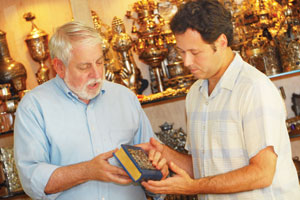 Klein has been reconnecting with history himself since his parents gave him the antique spice boxes that started his Judaica collection.
Klein has been reconnecting with history himself since his parents gave him the antique spice boxes that started his Judaica collection.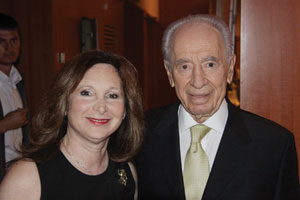 Karen Pack loves Israel. That passion drew her to the Jewish Agency for Israel, the organization that for more than 80 years has served as the link between the Jewish people and Israel, working to ensure the future of a connected, committed, global Jewish people with a strong Israel at its center.
Karen Pack loves Israel. That passion drew her to the Jewish Agency for Israel, the organization that for more than 80 years has served as the link between the Jewish people and Israel, working to ensure the future of a connected, committed, global Jewish people with a strong Israel at its center.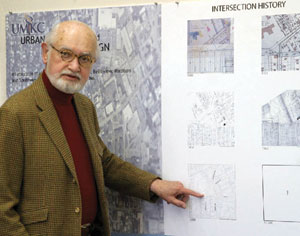 Architects describe Theodore Seligson as a legend in the field, and the Temple B’nai Jehudah member still shapes architecture, planning and design in Kansas City.
Architects describe Theodore Seligson as a legend in the field, and the Temple B’nai Jehudah member still shapes architecture, planning and design in Kansas City.